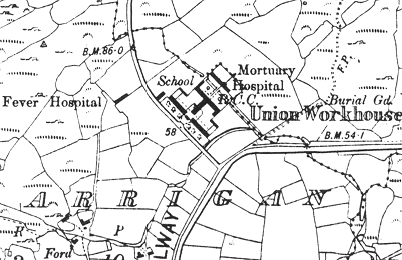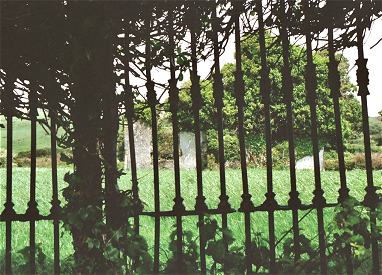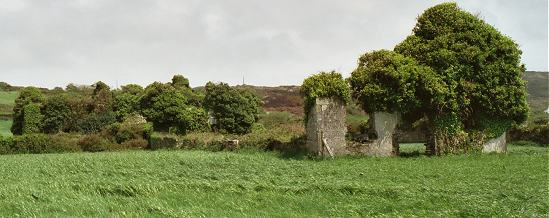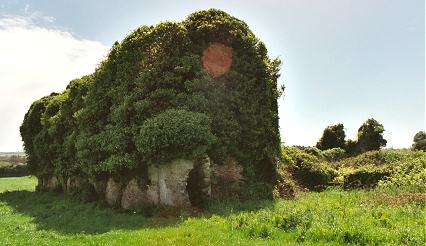Schull (Skull), Co. Cork
Schull (or Skull) was one of the new Poor Law Unions created in Ireland between 1848 and 1850. Schull Poor Law Union formally came into existence on 3rd October 1849. It was created from the western part of the Skibbereen Union and occupied an area of 89 square miles. The population falling within the Schull Union at the 1901 census was 11,233. In 1902, it comprised the following electoral divisions:
Co. Cork: Ballybane, Ballydehob, Coolagh, Crookhaven, Dunbeacon, Dunmanus, Goleen, Kilmoe, Lowerton, Skull, Toormore.
The Guardians met each week on Tuesday at noon.
On 19 January, 1850 the union opened a temporary workhouse at Lowertown Stores, East Schull. It appears that other premises may also have been employed. In April 1850, it was recorded (note plural) that:
SKULL UNION. State of the Workhouses, week ending Saturday the 13th April, 1850. Remaining on previous Saturday, 1,328; admitted during the week, discharged, 110; died, 7 ; remaining, 1,380. Number in infirmary, cost of provisions and necessaries consumed during the week, £47 13s. 10d. Average cost of an inmate, 8½d.; average cost in infirmary. 1s. 2¼d Number persons on out-dooor relief list, 1,355. Cost of out-door relief for the week, £25 8s. 6¼.
In March 1850, the guardians began adertising for builders to erect a new union union workhouse. Construction was carried out in 1850-1 on an eleven-acre site a mile to the north-east of Schull in a valley at the foot of Mount Gabriel. Owing to its situation at the head of Schull Bay, and its whitewashed walls, a local directory was later to describe it as "a striking object". Designed by the Poor Law Commissioners' architect George Wilkinson, the building accommodated 600 inmates. Its construction cost £6,000 plus £1,115 for fittings etc. The site location and layout are shown on the 1901 map below.

Schull workhouse site, 1901.
The layout was somewhat different to Wilkinson's earlier designs, and was a similar size and design to the workhouses at Clonakilty, Urlingford and Mitchelstown which were built at around the same time. The front of the site at the south-west would probably have had an entrance gate, flanked by two two-storey blocks which contained school rooms and accommodation for boys and girls.
To the rear, the main buildings had a T-shaped layout. The central wing running westwards towards the entrance probably contained the dining-hall and kitchens. To each side were accommodation wings for men and one for women. A hospital block and mortuary lay at the east of the site, with a burial ground nearby.
A description of the union and workhouse from December 1852 is given below:
SCHULL UNION.
The Schull Union has been only a few years in existence, and comprises an area of fifty-seven thousand acres, or an extent of country twenty-four miles long by something near eight miles broad. It takes in the extreme western portion of the country beyond Crookhaven. Previous to the formation of this union it constituted part of the Skibbereen Union, and some idea may be conceived of the hardship to which the destitute poor were exposed when they had to walk the entire way from Crookhaven to the workhouse Skibbereen for relief, and in some cases during the exigencies of the famine year, to return home without being admitted. The Schull union contains eleven electoral divisions, on which the following rates were struck the 25th March and the 29th of September 1852. The rates are annexed in the order of Ballydehob, 2s. 6d., 3s. 6d.; Ballyhain, 2s. 6d., 3s. 10d.; Coolagh, 2s. 4d., 3s. 5d.; Crookhaven, 1s. 4d., 3s. 4d.; Dunbeacon, 2s., 3s. 9d.; Dunmanus, 1s. 6d., 3s. 5d.; Goleen, 1s. 6d., 3s. 1d.; Kilcoe 1s. 9d., to 3s. 6d.; Lowertown, 2s. 3s. 6d.; Schull 2s. 6d., 3s. 7d.; Tourmore 2s., 2s. 10d. It might appear from this statement that destitution has increased in this union, from the circumstance of the last rate being than the former, but this is occasioned by its including no average of 1s. 6d. the pound for payment of the Government annuities.
The total number at present in be house is 274, of which there are 35 classed under head of able-bodied males, 44 under that of able-bodied females, while there are 125 children. There are 70 individuals in the hospital. Be total number for the corresponding period of 1851 was 450, and for that of 1850, 655, thus showing a progressive diminution of the pauperism of this union. Notwithstanding, however, that the poor-law classification gives 35 able-bodied males in the house return, any person at or over fifteen years of ago being thus regarded, there was only one able-bodied man in the establishment on the day I passed through it, and saw the male paupers at dinner. The remainder who were classed "able-bodied" were mere lads, none of whom looked to be more than from fourteen to sixteen years of age, and all of whom, without exception, it is but justice to state, appeared healthy and well-fed. The same remark will apply to the female paupers, the majority of whom are girls.
It has been omitted to state that there are about 10 acres enclosed within the walls of the Workhouse, and which are devoted to the cultivation of vegetables used in the pauper dietary. The boys who are not engaged in indoor employment cultivate this enclosure. There are at the present moment a large quantity of turnips grown on this soil, which cannot be consumed the house, and which the Guardians are seeking to sell. It is no exaggeration to say that probably such monster-sized vegetables are no where else to seen this country, several of them weighing from fifteen to nineteen pounds.
The mortality among the paupers in this house has been trifling, and is in no small degree a proof that its management is very satisfactory. During the half year ending the 29th September, the entire number of deaths has been twenty-nine, while the number relieved for the past twelve months has amounted to 1,192. The paupers get two meals day. In the morning the breakfast of the "able-bodied males" consists of a quart of stirabout and half pint of milk each; the "able-bodied females" receive a like quantity, and the "children" a graduated scale in proportion to their ages. The dinner of the class mentioned first, is composed of 11 oz. of brown bread and a quart of vegetable soup — the women get the same amount of soup, but their bread is less by two ounces.
The children get a pint and a half of soup, and ¾b. of brown bread for dinner. There is no mill on the premises for grinding, and the flour used in baking is consequently purchased outside, and then manufactured in the house. Out of a sack of flour weighing 20 stone there are produced 100 four pound loaves, which is something over the ordinary quantity. The brown bread given to the healthy j paupers is made of one-way flour, and, though dark and coarse, appeared to be wholesome and well tasted. As to the hospital bread, it really seemed as good if not superior to any household bread sold in the shops. The average cost of each pauper per week, including those in hospital, is 11¾ pence. The workhouse itself a light, agreeable-looking structure, and does not present that heavy, sombre aspect which buildings erected this country when first the Poor Law came into operation, invariably possess. There a stream of water running through the grounds of the establishment, over which there are archways leading from one department to another. The entrance from the road is through a handsome iron gate similar to that lending into a gentleman's demesne. There are fire-places in all the apartments, and in some two, and they are generally kept lighted during the day. With regard to the cleanly state of the house, walls, stairs, flooring, and bedding, nothing could be in better condition — in fact the stairs leading to the dormitories, as well as the floors of those apartments, looked perfectly unsoiled. It may stated in addition to the foregoing particulars that there are industrial operations going on the house, and which appear to be exceedingly well managed. Some of the boys have been instructed in weaving by a person who is employed for that purpose, and there are several looms in the industrial apartment. The articles woven are ticken, sheeting, shirting, flannels, and also ginghams; and it is only strict justice to state that every one of the products here enumerated is remarkably well made, particularly the material used for beds. The quality of the latter for strength and evenness of texture is really surprising, and its superiority over what had been previously supplied by contract is obvious at glance. There are other articles also made up the house, such as boys' caps, etc. The women and children are engaged in spinning and carding cotton wool and flax for the use of the looms, so that there does not appear to any idleness in the establishment. There is an overstock of clothing and other articles now manufactured, and the guardians have applied for liberty to sell to other unions, and which permission they expect to receive. With regard to the financial position of the union, a word or two will suffice. The entire valuation is £12,622, and the amount of the last rate was £2,461 18s. 8d. of which sum there has been collected £1,365 13s. 7d. The present balance in favour of the guardians is about £651.
In December 1908, the Local Government began an inquiry into a number of allegations that had been made regarding the master and matron of the workhouse and other union officers. Edward Roycroft, Chairman the Board of Guardians, was charged with conspiring with the matron and others to keep the Board in ignorance the marriage of his sister, the matron. William J. Roycroft, Clerk of the Union and the Rural District Council was charged with frequently remaining in the Workhouse overnight attending dances and card parties, and also conspiring with the chairman and matron to keep the Local Government Board in ignorance of the marriage of the matron. Anne Hurley, the matron, was charged with concealing the fact of her marriage four or five years previously from the knowledge of the Local Government Board, and also with keeping hens on the premises, and with permitting outside parties to remain in the workhouse, including her husband, John Hurley, W. J. Roycroft, the Clerk the Union, and Cornelius Moynihan, relieving officer, and also with permitting dancing and for the fraudulent misapplication the goods and provisions of the Union. Michael Barnett, master of the union, was charged with allowing William J. Roycroft and other outside parties to remain in the workhouse, and had invited and allowed people to play cards the workhouse, and had misapplied the goods of the Schull Union, and remained out of the workhouse late at night. Cornelius Moynihan was charged with staying in the workhouse night on several occasions, and for playing cards and attending dance parties. Inspectors reported that one morning, before sitting at the inquiry, they had entered the main gate of the workhouse and passed, without let or hindrance, into the boys' yard, and from there went round the farm, round the of the infirmary, into the female side, through the dining hall, and back again to the main gate without meeting a single locked door or any officer. The workhouse buildings were described as in a dilapidated condition. There was an absence of cleanliness some of the inmates were wearing their own clothing, and there was no appearance of a reserve stock of clothing, while as regards classification there was no observance of it, the officials Admitting that the classification doors were not kept locked during the day-time. The gaieties of the place consisted of music and dancing and card-playing in the porter's lodge, while, where the friends of deceased pauper inmates were inclined to bear the expense of entertainment, "wakes" in the workhouse were sanctioned by the guardians, and possibly participated in by some of them. The master and matron were subsequently dismissed and the other officers censured.
The building was burned down in the early hours of Sunday 24 June 1921 by Sinn Fein forces. Only a few overgrown ruins now remain.

Schull workhouse site entrance from the south-west, 2002
© Peter Higginbotham.

Schull main building from the west, 2002
© Peter Higginbotham.

Schull hospital block from the north, 2002
© Peter Higginbotham.
Records
Note: many repositories impose a closure period of up to 100 years for records identifying individuals. Before travelling a long distance, always check that the records you want to consult will be available.
- Cork City and County Archives, 33a Great William O'Brien Street, Blackpool, Cork. Holdings: Guardians' Minutes (1920-1924).
Bibliography
Links
- None.
Unless otherwise indicated, this page () is copyright Peter Higginbotham. Contents may not be reproduced without permission.


